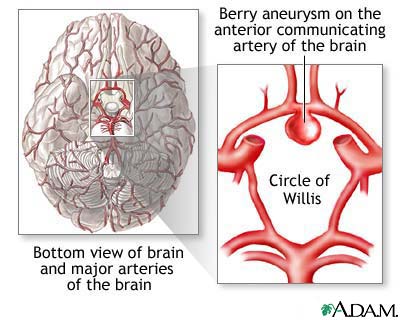Treatment
Symptoms often do not appear until bleeding (a rupture) occurs. A ruptured cerebral aneurysm is an emergency condition. The goal of treatment is to control symptoms and prevent further bleeding. Lowering blood pressure can reduce the risk.

Neurosurgery is the main treatment for cerebral aneurysm. The base of the aneurysm is closed off with clamps, sutures, or other materials that prevent blood flow through the aneurysm.
In many cases, an alternative to surgery can be done by placing special coils or stents into the aneurysm through the arteries, which causes a clot to form and prevents further bleeding. This approach is considered less invasive than brain surgery, and in the appropriate circumstances, it is regarded as the best form of treatment.
If surgery cannot be done because of the patient’s overall condition or the aneurym’s location or size, medical treatment is similar to treatment for subarachnoid hemorrhage. Treatment may involve:
* Complete bedrest and activity restrictions
* Drugs to prevent seizures
* Medicines to control headaches and blood pressure
Once the aneurysm is repaired, prevention of stroke due to blood vessel spasm may be necessary. This may include intravenous fluids, certain medications, and actually letting one’s blood pressure run high.
Prognosis (Expectations)
The outcome varies. Patients who are in deep comas after an aneurysm rupture generally do not do as well as those with less severe symptoms.
Ruptured cerebral aneurysms are often deadly. About 25% of people die within 1 day, and another 25% die within about 3 months. Of those who survive, more than half will have some sort of permanent disability.
Complications
* Increased fluid pressure inside the skull
* Loss of movement in one or more parts of the body
* Other neurological problems (such as vision changes, difficulty speaking, or cognitive decline)
* Permanent loss of sensation of any part of the face or body
* Seizures, epilepsy
* Stroke
* Subarachnoid hemorrhage
Calling Your Health Care Provider
Go to the emergency room or call the local emergency number (such as 911) if sudden or severe headache occurs, particularly if you also have nausea, vomiting, seizures, or any other neurological symptoms. Also call if you have a headache that is unusual for you, especially if it is severe or “the worst headache ever.”
Aneurysm in the brain: Overview, Causes
Aneurysm in the brain: Symptoms & Signs, Diagnosis & Tests
Aneurysm in the brain: Treatment
Reviewed By : A.D.A.M. Editorial Team: David Zieve, MD, MHA, Greg Juhn, MTPW, David R. Eltz. Previously reviewed by Daniel B. Hoch, PhD, MD, Assistant Professor of Neurology, Harvard Medical School, Department of Neurology, Massachusetts General Hospital (9/27/2008).
